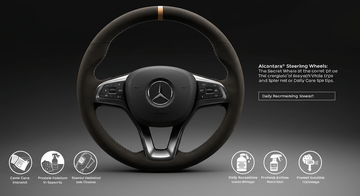Your steering wheel is the bridge connecting you to your car, and more importantly, it's the center of your driving experience. At HyperSteering, we understand that every custom steering wheel embodies your pursuit of ultimate driving pleasure. That's why we insist on using the finest materials and exquisite craftsmanship to create enduring works of art. And proper care is the key to ensuring these meticulously crafted HyperSteering steering wheels remain as new.
The lifespan of your steering wheel, whether it's made of carbon fiber, Alcantara, or genuine leather, is a complex issue involving material properties, maintenance practices, and common wear factors. This guide provides practical tips for extending its life, detailing characteristics, care methods, and common causes of wear for each material.
I. Genuine Leather Steering Wheels
Common Wear Causes:
- Sun Exposure: Accelerates aging.
- Hand Sweat: Leads to a greasy patina.
- Sharp Objects: Cause scratches.
- Cleaning Agents: Can cause corrosion.
- Prolonged Humidity: Leads to cracking.
Lifespan Extension Tips:
is more than just an accessory; it's a piece of art within your car's interior and an extension of its performance. We understand your desire to cherish it, which is why we consider long-term durability from the very beginning of its design and production. By avoiding prolonged direct sunlight, using a steering wheel cover, and handling it gently, you can effectively protect this investment, ensuring your custom HyperSteering steering wheel continues to provide an exceptional driving experience for years, even decades, to come."
-
Sun & Heat Protection:
- Prioritize parking in underground garages or shaded areas to avoid direct sunlight.
- Use a sunshade to reduce interior temperatures and slow down leather hardening.
-
Cleaning & Maintenance:
- Cleaning: Gently wipe surface stains with a soft, damp cloth (wrung out). Avoid excessive moisture. Do not use cleaning agents containing alcohol or strong chemicals.
- Maintenance: Every 3 months, apply a specialized leather conditioner (e.g., COLOURLOCK) to keep the leather soft and repair minor cracks.
-
Protective Measures:
- Hand Sweat Protection: Wear driving gloves if you have sweaty hands to prevent sweat penetration.
- Avoid Physical Damage: Avoid wearing rings or sharp accessories while driving to prevent scratching the leather.
-
Steering Wheel Cover Controversy:
- Cautious Installation: Poor-quality or ill-fitting steering wheel covers can cause slipping, safety hazards, or deform the original leather due to compression. If used, choose a custom-fit, anti-slip design and replace it regularly.
II. Alcantara (Suede-like) Steering Wheels
Common Wear Causes:
- Hand Oils/Sweat: Easily stained, forming a greasy patina.
- Dust Accumulation:
- Improper Cleaning: Leads to matted fibers.
Lifespan Extension Tips:
-
Immediate Stain Cleaning:
- Best to treat stains within 30 minutes of occurrence.
- Use a dedicated Alcantara cleaner (e.g., COLOURLOCK Leather Cleaner) with a soft brush, gently brushing to avoid fiber detachment.
-
Regular Deep Cleaning:
- Monthly, gently wipe with a slightly damp towel dipped in a small amount of neutral detergent (e.g., diluted dish soap), then blot dry with a clean, dry towel.
- For severe oil stains, pre-treat with a fat-absorbing spray.
-
Protection & Repair:
- Wear gloves while driving to reduce direct contact.
- If matting occurs, use an Alcantara repair brush to restore the texture; severe wear requires professional refurbishment.
III. Carbon Fiber Steering Wheels
Common Wear Causes:
- Prolonged UV Exposure: Leads to yellowing of the resin layer.
- Physical Impact: Causes cracking.
- High Temperatures: Affects adhesives.
Lifespan Extension Tips:
-
Sun Protection & Temperature Control:
- Avoid prolonged sun exposure; use a sunshade when parked.
- Do not wipe immediately with cold water after high temperatures in summer, to prevent thermal expansion/contraction causing micro-cracks.
-
Avoid Physical Damage:
- Drive carefully to prevent collisions; carbon fiber, while lightweight, has lower impact resistance than metal.
- When cleaning, use a microfiber cloth; do not use hard brushes.
-
Daily Maintenance:
- Regularly wipe the surface with a neutral cleaner to maintain its luster.
- Check adhesive edges every six months to prevent cracking.
IV. General Maintenance Tips (Applicable to All Materials)
-
Optimize Driving Habits:
- Avoid excessive force when turning the steering wheel sharply to reduce mechanical wear.
- Reduce frequent hard acceleration/braking to lessen stress on the steering wheel.
-
Parking Environment Management:
- When parked for extended periods, keep the car interior dry; use dehumidifiers to prevent moisture corrosion.
-
Common Cleaning Principles:
- For all materials, avoid alkaline cleaning agents like laundry detergent or soap.
- Thoroughly wipe dry after cleaning to prevent moisture from seeping into internal structures.
V. Material Comparison & Selection Advice
⚠️ Important Reminders:
- Steering wheel covers must be chosen carefully; poor-quality products can cause slipping or interfere with airbag deployment.
- If the material is severely worn, prioritize professional repair over self-treatment.
By implementing targeted maintenance and adjusting habits, you can significantly extend your steering wheel's lifespan and maintain optimal feel.
FAQs
Does the resin layer of carbon fiber steering wheels permanently discolor in high temperatures?
The question of whether the resin layer of carbon fiber steering wheels permanently discolors in high temperatures requires analysis combining material science and real-world performance.
Lynk & Co's dry carbon fiber steering wheel utilizes a high-temperature compression molding process, one of its advantages being "high temperature resistance without discoloration." This is because of its extremely low resin content, which prevents yellowing in high temperatures, maintaining a fresh look for a long time. This suggests that under normal use conditions, the resin layer of carbon fiber steering wheels has good high-temperature resistance and will not permanently discolor due to heat.
However, indicates that when resin loses rigidity in high-temperature environments, the performance of composite materials can be affected, especially when processed or exposed to continuous high temperatures, which may lead to permanent damage to the matrix material. While this evidence does not directly mention carbon fiber steering wheels, its description of high temperature's impact on resin performance serves as a reference. If a steering wheel is exposed to extreme heat for extended periods, it could lead to degradation of the resin layer's performance and even permanent discoloration.
further explains potential issues with resin at high temperatures. If resin undergoes thermal decomposition at high temperatures, it may produce free radicals, and prolonged stagnation in the molding machine barrel can result in tar-like substances, changing the color to brownish-black. Additionally, UV light can also cause resin discoloration, turning it from yellow to brownish-black. This implies that if a carbon fiber steering wheel is exposed to high temperatures or UV radiation for extended periods, its resin layer might permanently discolor.
In conclusion, whether the resin layer of a carbon fiber steering wheel permanently discolors in high temperatures depends on specific usage conditions and the material's heat resistance. Under normal use conditions, as mentioned, the resin layer exhibits good high-temperature resistance and will not permanently discolor. However, if used in extremely high or prolonged high-temperature environments, or simultaneously exposed to UV radiation, the resin layer might experience permanent discoloration.
Does an Alcantara steering wheel need polishing after using a specialized cleaner?
Based on the research, here's a conclusion regarding whether an Alcantara steering wheel needs polishing after using a specialized cleaner:
Some sources suggest polishing: Some articles explicitly state that after cleaning an Alcantara steering wheel with a specialized cleaner, it's recommended to polish it with a leather protective polish to restore its luster and extend its lifespan. For example, both mention that after using a specialized cleaner, a leather protective polish should be gently applied for better shine. This indicates that polishing can be a supplementary step after cleaning to enhance Alcantara's appearance.
Other sources emphasize avoiding over-treatment: states that if Alcantara surfaces show matting, they can be treated using a leather sanding pad, but specifically warns against using traditional sandpaper. Additionally,notes that Alcantara surfaces are very delicate and excessive pressure or strong rubbing should be avoided to prevent damage. Therefore, if the Alcantara surface has no obvious dirt or aging issues, polishing might not be necessary.
Function of the cleaner itself: mention that specialized Alcantara cleaners often have protective functions, forming a protective film to prevent dust and oil adhesion. Such cleaners might already provide some conditioning effects, thus potentially eliminating the need for an additional polishing step in some cases.
Daily maintenance recommendations: both emphasize the importance of daily maintenance, recommending regular cleaning with mild detergents and microfiber cloths, and avoiding harsh chemicals. If the Alcantara steering wheel shows no significant wear or stains, routine maintenance might suffice without the need for polishing.
Conclusion: Whether an Alcantara steering wheel requires polishing after using a specialized cleaner depends on its surface condition. If the surface still has noticeable stains or signs of aging after cleaning, it's advisable to polish it with a leather protective polish to restore luster and extend lifespan. However, if the Alcantara surface is in good condition and only requires cleaning, additional polishing may not be necessary. Furthermore, avoid strong rubbing or improper cleaning products to prevent damage to the Alcantara material.
Does a genuine leather steering wheel need regular leather softening after using a leather conditioner?
Based on the research, here's a conclusion regarding whether a genuine leather steering wheel needs regular leather softening after using a leather conditioner:
Purpose of Leather Conditioner: Leather conditioners are typically used to clean and nourish genuine leather, maintaining its softness and shine. For instance, mentions that using professional leather conditioners can "maintain the luster and elasticity of the leather, slowing down the aging process," but advises against conditioners containing solvents, strong acids, or strong alkalis. also states that leather conditioners can "maintain the softness and luster of leather" and prevent cracking, fading, etc.
Necessity of Leather Softener: While leather conditioners can provide some nourishment, whether a separate leather softener is needed regularly depends on the conditioner's ingredients and frequency of use. If the conditioner already contains softening agents, an additional softener might not be necessary. However, if the conditioner primarily focuses on cleaning and protection without providing sufficient nourishment, then regular use of a leather softener is advisable.
Frequency of Leather Softener Use: suggest that leather softeners are typically used every 3-6 months, depending on the usage environment and leather type. For example, [Source 5] states: "The frequency of maintaining leather bags depends on the type of leather and usage conditions, generally recommending the use of a leather softener or oil every six months to a year." further explain that the frequency of leather softener use should be adjusted based on usage frequency and environmental conditions, such as "moisturizing every 3 to 6 months, with the specific frequency depending on environmental exposure and usage." also mentions that if leather boots are used frequently, they should be softened monthly; if used less often, every 3 to 6 months is sufficient.
Comprehensive Recommendation: If your genuine leather steering wheel conditioner already provides sufficient nourishment, you likely don't need an additional leather softener. However, if the conditioner primarily focuses on cleaning and protection without providing adequate conditioning, then it's recommended to regularly use a leather softener to maintain the leather's softness and extend its lifespan. Additionally, states that regular use of leather care products specifically designed for automotive interiors is key to maintaining the good condition of a genuine leather steering wheel.
In summary, whether a genuine leather steering wheel needs regular leather softening after using a leather conditioner depends on the conditioner's ingredients and usage frequency. If the conditioner provides sufficient nourishment, an additional softener might not be needed; but if the conditioner primarily cleans and protects, regular use of a leather softener is recommended to maintain softness and extend lifespan.
Can a steering wheel cover affect the normal deployment of an airbag?
The question of whether a steering wheel cover can affect the normal deployment of an airbag has been debated across multiple sources, with not entirely consistent answers. We can analyze this from several angles:
Some views suggest steering wheel covers do not affect airbag deployment. For example, explicitly state that steering wheel covers generally do not interfere with the normal functioning of airbags. The airbag is located in the center of the steering wheel, and its deployment direction is independent of the steering wheel cover. Even in the event of a collision, the airbag can distribute impact force evenly across the occupant's head and chest, significantly reducing the risk of injury. Furthermore, the articles mention that hand-stitched steering wheel covers also do not affect airbag deployment.
Other views, however, indicate that improperly chosen steering wheel covers might hinder airbag deployment. For example, all mention that if a steering wheel cover is too hard, too thick, or improperly installed, it might obstruct the airbag's deployment, affecting its speed and effectiveness, or even preventing it from fully deploying. specifically points out that when an airbag deploys at 300km/h, any material covering the steering wheel (especially plush or chemical fiber types) can obstruct the airbag's deployment and even turn decorative items into shrapnel. also notes that steering wheel covers can prolong airbag deployment time, alter its deployment direction, or even break into pieces during deployment, becoming secondary injury "projectiles."
The design and function of airbags themselves incorporate certain safety mechanisms. mention that while airbag explosive force is strong, its main component is harmless nitrogen gas, and the powder produced during deployment is a harmless lubricant. The airbag deployment volume is about 130 decibels, which is within human tolerance. Therefore, steering wheel covers should not disrupt these safety mechanisms under normal use.
New regulations from traffic police departments also caution about the safety of steering wheel covers. indicates that improperly sized steering wheel covers can lead to slipping, affecting driving control, and potentially hindering airbag deployment. To ensure driving safety, vehicle owners should avoid installing such accessories, choose legitimate brands, and ensure window film light transmittance meets standards.
Conclusion: Whether a steering wheel cover affects normal airbag deployment depends on its material, thickness, and installation method. If an appropriate material (e.g., thin, breathable material) is chosen and securely installed, a steering wheel cover generally will not impact airbag deployment. However, if a thick, plush, or chemical fiber material is chosen, or if it's improperly installed, it might obstruct normal airbag deployment in an emergency, thereby affecting its protective efficacy. Therefore, when selecting a steering wheel cover, vehicle owners should carefully consider its safety and prioritize models that meet safety standards.
Can a cracked carbon fiber steering wheel be repaired by heating with a heat gun and re-adhering it?
which discusses the properties of low-temperature thermoplastic materials, heating such materials can give them a certain degree of plasticity and adhesive quality. Specifically, the article states that when a brace is damaged, for instance, with cracks, the damaged area can be heated with a heat gun to restore the brace, making it very strong.
While primarily discusses the application of low-temperature thermoplastic materials in fracture treatment, its description of heating and adhesion principles is relevant to other materials with thermoplasticity or plasticity. If the material of a carbon fiber steering wheel can soften and reform its structure after heating, then, theoretically, it might be possible to repair a crack by heating it with a heat gun and re-adhering it. However, it's important to note that carbon fiber itself is a high-strength, high-modulus composite material and typically does not possess the thermoplastic properties of plastics. Therefore, whether it can be re-adhered through heating depends on the specific type of material used in the carbon fiber steering wheel and its manufacturing process.
If the surface or joints of the carbon fiber steering wheel have a coating or adhesive layer, these materials might soften and re-adhere when heated, thus allowing for repair. But if it's a pure carbon fiber structure without plasticity or adhesive qualities, then heating might not achieve the desired effect. Furthermore, the structural integrity of the repaired area needs to be considered, along with the material's heat resistance and structural stability.
Conclusion: Whether a cracked carbon fiber steering wheel can be repaired by heating with a heat gun and re-adhering it depends on the material's properties and the applicability of the repair method. If the material possesses a certain degree of thermoplasticity and adhesive quality, then this method could be feasible; otherwise, other repair methods might be necessary.
Proper maintenance habits will allow your steering wheel, especially a custom product like those from HyperSteering that has countless hours of dedication poured into it, to always shine like new. We believe that an extreme pursuit of detail is not only reflected in our manufacturing process but also in your daily care for your beloved car. Ready to experience a truly enduring driving companion? Explore HyperSteering's custom steering wheel collection now, and choose a worthwhile long-term upgrade for your vehicle!










